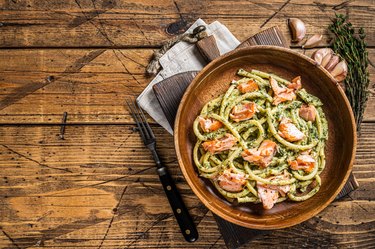
It looks like spaghetti, only longer. It cooks like spaghetti, but takes longer. Bucatini is one of 350 varieties of pastas, each serving a specific purpose when covered with sauce. Bucatini's identifying hollow center, (buco means hole in Italian) allows it to not only get coated with a hearty sauce, but the vacant center means the pasta's interior gets filled with sauce as well. Think of bucatini as giving you more bucatini bang for your buck.
Bucatini: The Hollow Spaghetti
Video of the Day
Unlike rigatoni or ziti, the plump pastas with a hollow center, or penne, a smaller, thinner version of rigatoni, bucatini's resemblance to spaghetti often confuses cooks who thought they were bringing home spaghetti. Shepherds around Amatrice, Italy, north of Rome, were credited with creating bucatini but how they got the hole in the center is a matter of legend and which one you believe.
Video of the Day
Today, the hole is created by a metal disk attached to the pasta maker and the dough is passed through the disk, wrapping itself around a hole in its center. When cooked in salted water, bucatini's shape results in an evenly cooked pasta.
Preferred Sauces for Bucatini
Classic bucatini all'Amatriciana, named after its region of origin and popular since the early 19th century, is the preferred recipe for bucatini. Originally made with guanciale, cured pork cheeks, your local butcher may look at you with a blank stare when you ask for pork cheeks. Good substitutes for the cheeks include bacon or pancetta. Additional ingredients for the sauce are a matter for debate, as all Italian mamas have their own recipe for all'Amatriciana. Parsley? Maybe. Onion? Yes or no, depending on where mama is from. Whole tomatoes? Absolutely. Also garlic. Top the cooked bucatini with a healthy helping of the sauce and savor a special Italian treat.
Other sauces for bucatini include carbonara, a rich silky sauce made with pancetta, eggs and pecorino cheese. True carbonara sauce does not include cream or milk. Bolognese is another sauce perfect for hearty bucatini. Rich with ground beef and pork, the tomato sauce is flavored with celery, carrots, pancetta and finished with a dash of heavy cream.
The Great Bucatini Heist
During the Covid pandemic, bucatini began to disappear from grocery shelves. The reason reads like a version of the Godfather and involves the FDA, the National Pasta Association, DeCecco executives and an intrepid reporter named Rachel Handler. The answer as to why the pasta was banned for nearly a year comes down to its lower-than-required iron content. A rat, i.e., likely competitor, informed the FDA that DeCecco was out of compliance regarding the required amount of iron in the pasta and bang! Banned! The problem has been fixed, however, and fans of DeCecco Bucatini can now find it on the shelves.
Malibu’s Version of Bucatini Pasta
Everyone knows that the enclave of Malibu, that pricey, oceanfront version of Nirvana off the Pacific Coast Highway in Southern California, has always been environmentally conscious, except when the houses get swept away in a storm. A restauranteur, in an effort to eliminate paper straws, chose bucatini to serve with his drinks. A sip through a pasta straw became de rigeur, and now the Paradise Beach Cove Café not only serves drinks with bucatini straws, but sells them as well, in compliance with the "no plastic straws" law now in effect in Los Angeles.